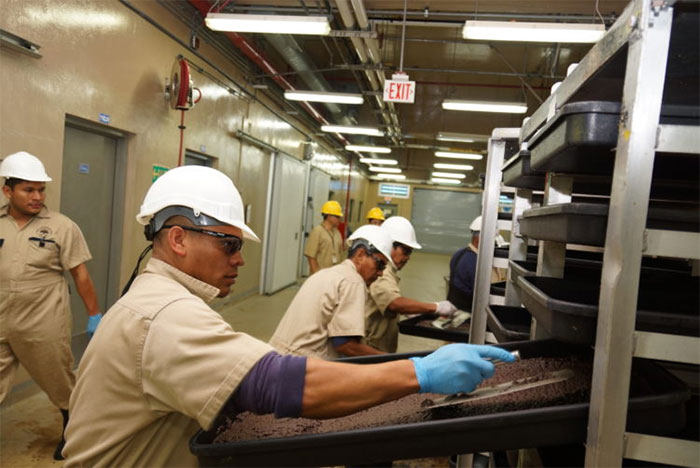The only fly factory in the world
This is the only plant in the world that allows Panamanian and American scientists to work together to produce and release over 20 million irradiated flies every week, making them infertile.
Located in Panama, amidst rainforests, fields and the Pacora River, the green-roofed fly factory looks like any other production facility in the world. The difference is that this plant is run by the governments of Panama and the United States with the main task of raising flies.

Workers at the factory - (Photo: Usembassy).
This plant produces millions of flies a week, more than a billion flies a year. The atmosphere inside the plant is characterized by the smell of rotting flesh because the fly larvae are raised on a diet carefully with milk, eggs, fiber and cow blood.
However, this is not the common fly we still see. This is a fly with a worm-like larva (scientific name: Cochliomyia hominivorax). The larvae of this fly are highly destructive, to combat them, the scientists radiated larvae in the laboratory, causing them to hatch sterile flies before releasing them into the wild in Central America. .
Raising this predatory larval larva is a complex, little-known but extremely important job. It was part of a decades-long effort to protect cattle across North and Central America.
Flies are shiny green, 2 to 3 times the size of a housefly, often laying eggs in the open wound of warm-blooded animals - this is the food environment to feed the fly larvae. The preferred 'prey' of young larvae is cattle and they can lay eggs into wounds as small as flea bites and subsequently, causing animal death. In the first half of the 20th century, this fly larvae cost up to US $ 20 million a year in agriculture.
Scientists have found a way to prevent helminth larvae. They regularly release millions of irradiated flies that make infertility at weekly intervals, destroying them from the US to Central America. Now, 25 years after the US and Panama first collaborated, the program was a success, keeping both humans and animals free of helminths.
The flies have a unique biological mechanism. The females mate only once in their 3-week lifespan, so if the male mates with them are infertile, there will be no new larvae. Saturation of an area with many infertile males will result in the overall collapse of the surrounding fly ecosystem. This insect sterility technique is also used to kill flies that transmit sleep disease to humans on the island of Unguja in Zanzibar.

Flies plant viewed from above.(Image source: Usembassy).
By exploiting this biological weakness of the carnivorous larvae, the US government was able to eradicate the problem caused by cattle in 1966. According to the United States Department of Agriculture (USDA), Using insect sterility techniques is one of the most entomological success stories of all time.
After the USDA program sought to wipe out these insects in the United States, they were pushed further south. By 1991, Mexico was also free from flies. Then, in Belize, Guatemala, El Salvador, Honduras, Nicaragua and Costa Rica. Currently, helminth larvae are still present on the Colombian border.
In order to maintain the process against tilapia larvae , scientists annually release billions of irradiated males, overwhelming the males in the wild. Infertile male flies are currently flown by plane six times a week across the southeastern Darién region of Panama.
- The world's first biscuit factory from Roman times
- 10 largest manufacturing plants on the planet
- Video: Swiss factory specializes in exhaust fumes for resale
- Intel inaugurated 65nm technology chip factory in Ireland
- Matsushita invests in the world's largest plasma TV factory
- China built the world's largest rocket factory
- Brazil builds green 'plastic manufacturing factory'
- Inside the factory with BMW's
- Visit Elon Musk's super factory, where the Tesla electric car battery is born
- Discover inside the world's largest condom factory
- Vietnam for the first time has a factory that applies nano-silver technology
- China: Micro launched the first chip factory
 The quiet, mysterious life of Vietnam's first female doctorate 'Western Studies'
The quiet, mysterious life of Vietnam's first female doctorate 'Western Studies' The 10-year-old girl has higher IQ than Albert Einstein and Stephen Hawking
The 10-year-old girl has higher IQ than Albert Einstein and Stephen Hawking China opens the cable-stayed bridge with the tallest concrete tower in the world
China opens the cable-stayed bridge with the tallest concrete tower in the world The most 'astronaut' astronaut in the world: Abandoned in outer space for 311 days!
The most 'astronaut' astronaut in the world: Abandoned in outer space for 311 days!